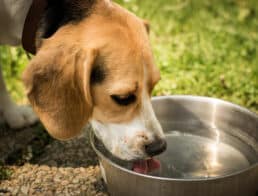Finding quality dog food for puppies is more crucial to your dog’s lifelong health than you may think. Nutrition is one of the most important ways that we can keep our puppies healthy. You might not think much of the small dry kibble that is in your dog’s bowl, but each piece contains essential vitamins and minerals that help to prevent certain diseases while optimizing growth and development. There are hundreds of diets available for dogs, so how do you know which diets are the best? Which ones are the best to feed your puppy?
Our vet advisor, Dr. Erica Irish, carefully evaluated the criteria for puppy food and came up with the best of the best. She looked at the quality of wet and dry puppy foods and the health and nutrition benefits of each. She found excellent foods for various stages in your puppy’s life and determined that Pro Plan’s Focus Chicken & Rice Formula Dry Puppy Food is the best overall choice. Read how she chose the top 5.
While you’re considering what food to feed your puppy, don’t forget to pay careful consideration to what table foods are to be avoided and which are healthy additives.
Our Vet’s Top 5 Dog Food for Puppies
Here are the top picks from our veterinarian. Compare the ratings and features of different models.
| Vet’s Picks | Model | Rating | #1 Ingredient | Wet or Dry | Breed Size Specific |
|---|---|---|---|---|---|
| Best Overall | Pro Plan’s Focus Chicken & Rice Formula Dry Puppy Food | Chicken | Dry | No | |
| Best Budget Buy | Eukanuba Puppy Large Breed Chicken Flavor Dry Dog Food | Chicken | Dry | Large | |
| Best Canned | Hill’s Science Diet Puppy Chicken & Barley Entrée Canned Dog Food | Water | Wet | No | |
| Best for Large Breeds | Royal Canin Large Puppy Dry Food | Corn | Dry | Large | |
| Best for Young Puppies | Royal Canin Small Starter Mother and Babydog Dry Dog Food | Chicken meal | Dry | No |
*Ratings are on a scale of 1 to 5 and based on reviews, feedback, and opinions of actual customers
Who Should Buy Dog Food for Puppies
- New puppy parents – Just as a human baby has different nutritional needs to an adult (or even child), the same is true for a puppy versus an adult dog. A puppy is in need of developmental nutrition, requiring specially formulated food to meet their nutritional needs.
- Transitioning puppies – You may find your puppy growing out of his early puppy stage faster than you want, but you’ll need to make sure you’re keeping him on his puppy food diet for as long as he needs – and that means finding a puppy food that will transition with him as he grows. 1
- Teething puppies – Puppies do get their teeth relatively early, but those teeth are better suited for softer foods right after the puppy is weaned. You’ll need to slowly transition to harder foods as he ages.
- Pregnant and lactating adult dogs – Pregnant and lactating adult dogs benefit from puppy food to meet their increased calorie needs.
Who Should Not Buy Dog Food for Puppies
- Puppy graduates – Your dog will age out of puppy food, depending on the breed and size, at roughly a year old. You may want to consider “young adult” food to help your pup transition into adulthood.
- Adult dogs – You’ll be able to make the switch to the less specific diet of “adult” dog food after he’s reached adulthood. Transitioning to adult food too early could have a lifelong negative impact on his development. Pregnant and lactating adult dogs are the exception; they should be fed puppy food to help keep their calories up.
Research Tips (From a Veterinarian)
The following list is meant to help guide you when navigating the commercial food market. It should not contradict any recommendations from your own veterinarian, and if you need further clarification or special recommendations, it is best to discuss them with your vet.
- Look for a reputable manufacturer – Not only should these companies rely on scientific evidence rather than marketing trends when it comes to recipes, but they should also have strict quality control protocols to ensure that their products are safe and effective.
- Pay attention to the ingredients list – For selection criteria, the best puppy diets should come from companies that use high-quality ingredients and include antioxidant-rich vitamins like vitamin E.2
- Look for omega-3s – Babies need omega-3 fatty acids – including both fur babies and human babies. This is most often found in fish oil, and in your dog’s food, it will go a long way in helping brain development. Make sure you’re weighing the benefits and checking the ingredient list to see if your puppy’s food contains omega-3 fatty acids.3
- Don’t skip transition food – There’s a large window between puppy and adult, and a lot of smaller steps in between. Look for the food that has the necessary nutrients and meets his specific needs. There are dog foods that are designed with “young adult” or “older puppy” diets in mind, and finding those may just make the transition easier and support your pup’s development as he grows.
- Weight wet vs. dry food – For a young puppy, soft food may be necessary when he first makes the transition away from mama’s milk. A newly weaned puppy will struggle to eat anything solid, so a particularly hard dog food may not be the best idea when the puppy is under a few months old. Older puppies will need help with teething, and dry dog food can offer that.
How Much Do They Cost?
Between $1 and $2 a day
How much it costs to feed your puppy will vastly differ depending on the breed and your preferences. If you have a large breed dog, you’ll spend more money feeding her than you would a small breed puppy. A puppy under six months old will eat three times a day, and a puppy over six months will eat two meals per day (as he likely will for the rest of his life). If you opt for wet food over dry, you’ll be spending more per meal, as well. You’ll want to make sure your puppy’s getting enough to eat, regardless of cost, but you can expect to spend somewhere between $1 and $2 each day. If you’re looking for a more accurate representation of how much food your puppy will eat each day, then try the AAHA’s Canine Life Stage Calculator.
Our Methodology: Why Trust Pango Pets
As a vet, I’ve walked dog owners through the nutritional requirements of their new puppies countless times. Commercial dry and wet puppy foods are considered nutritionally complete if they meet the requirements set forth by AAFCO, which is the Association of American Feed Control Officials. It is especially important for puppies to eat nutritionally complete foods because diets that are under-supplemented or over-supplemented with vitamins can cause orthopedic issues, eye disease, and other health problems. – Dr. Erica Irish
The Best Dog Food for Puppies: Full Reviews
Purina has many different dog food brands, but Pro Plan is considered their top-tier line of diets. They contain the highest quality protein sources and have excellent palatability for all dogs. Pro Plan’s Focus Chicken & Rice Formula Dry Puppy Food uses chicken for its protein source, and it contains fish oil which is rich in omega-3 fatty acids like DHA. Dogs cannot produce omega-3s on their own. They are important for skin, heart, and brain health. Diets with high levels of DHA are especially important for brain and eye development in puppies.4
This diet also contains antioxidants and probiotics. Antioxidants are compounds that help to remove free radicals, which are damaging molecules that form due to various chemical reactions in the body.5 Probiotics are beneficial bacteria that play an important role in the response of the immune system to invading organisms in the digestive tract. They can also block these organisms from attaching to the lining of the intestines.6
- Antioxidant-rich for developing immune systems
- Smaller kibble for easy chew
- DHA from fish oil
- No taste variety
- May cause bad breath
Eukanuba is another reputable company that makes diets with high-quality ingredients and works diligently to ensure good quality control. They also provide diets that may be a little less expensive than their competitors. Eukanuba’s Puppy Large Breed Chicken Flavor Dry Dog Food can be purchased in bags as large as 33 pounds. This is important because large breed puppies go through a lot of food!
Like the above diet, it contains high levels of DHA for healthy brain development.7 The vitamin E in this diet has an antioxidant effect in the body, and the diet contains a prebiotic blend that helps to maintain a healthy digestive tract.8 While probiotics are beneficial gut bacteria, prebiotics are the food for the beneficial bacteria.9
- Guaranteed levels of antioxidants
- Natural fiber for gentle digestion
- Prebiotics for immune and digestive health
- No taste variety
Hill’s is a food company that has created a number of different diets, from puppy to adult, and from commercial to therapeutic. They maintain excellent quality control standards and work with veterinary nutritionists to develop their diets. Puppy foods need to be formulated with growth and development requirements in mind, which is why Hill’s Science Diet Puppy Chicken & Barley Entrée Canned Dog Food is ideal for young puppies.
Canned diets have more water content than dry foods, and they tend to be a little more tempting for the picky puppy to eat. Formulated for small breed puppies, Hill’s Chicken & Barley canned food contains excellent amounts of DHA and antioxidants. It has a higher calorie content since puppies need much more than adult dogs do, but pregnant and lactating dogs can also eat this canned diet.
- Balanced for bone and teeth development
- DHA from fish oil for brain and eye development
- Feeding guide on can
- Must refrigerate after opening
- Cost per meal is high
Royal Canin is one of the best dog food companies. They have an excellent track record for complete diets and high-quality standards. In fact, they regularly check the makeup of their diets to ensure that there isn’t any cross-contamination between their different foods. This is important for dogs with food allergies. Royal Canin tends to put less of their money into advertising and more of it into the scientific research that goes into the development of their diets.
Royal Canin Large Puppy Dry Food has many of the same ingredients and benefits contained in the other diets, but their palatability is one of the best, and the company will take back an open bag of food if your puppy doesn’t like it. The texture of the kibble is great for dental health, and the formula of the diet is ideal for the growth of a large breed dog. It is important to get the right balance of calcium and phosphorus for the development of bone because orthopedic issues can occur if the ratio is thrown off balance.10
- Engineered for the joint and bone development of large breeds
- Antioxidant-rich for immune system support
- Prebiotics for digestive health
- Chicken by-product
If you have puppies in your home that are very young, there aren’t many diets that are approved for use in puppies greater than eight or nine weeks of age. Ideally, puppies younger than that should be nursing from their mother, or they should be exclusively fed puppy milk formula if there is a situation where mother’s milk is not an option. Royal Canin’s Small Starter Mother and Babydog Dry Dog Food is a great first introduction to a regular diet.
This particular food is safe for puppies to eat as early as three to four weeks of age, and they can continue eating it up until about two months of age. The kibbles are tiny yet contain a lot of calories, which is essential because puppies need so much more energy than adult dogs. Since pregnant and lactating mothers also need a lot of calories, this diet is an excellent choice for everyone involved.
- Same food for mom and pup
- Rehydrates both mom and pup after delivery
- Small kibble for easy chew
- Small window of usability
- Strong odor
Frequently Asked Questions
What is dog food for a puppy and how is it different?
Can a puppy eat regular dog food?
When should you switch your puppy to dog food?
What are the best times to feed a puppy?
- Williams K, Downing R. Feeding growing puppies. Vcahospitals.com. Accessed February 9, 2021.
- Jewell D, Yu S, Joshi D. Effects of Serum Vitamin E Levels on Skin Vitamin E Levels in Dogs and Cats. Vetfolio.com. Published March 8, 2019. Accessed March 23, 2021.
- Oke S. Boosting Puppy Brains for Trainability with Omega-3 Fatty Acids. Akc.org. Published May 19, 2016. Accessed March 23, 2021.
- Lenox C. Role of Dietary Fatty Acids in Dogs & Cats. Todaysveterinarypractice.com. Accessed May 3, 2021.
- Ware M. How can antioxidants benefit our health? Medicalnewstoday.com. Published May 29, 2018. Accessed May 3, 2021.
- Forever Vets Animal Hospital. A Complete Guide to Probiotics for Dogs. Forevervets.com. Accessed May 3, 2021.
- Oke S. Boosting Puppy Brains for Trainability with Omega-3 Fatty Acids. Akc.org. Published May 19, 2016. Accessed May 3, 2021.
- Traber MG, Atkinson J. Vitamin E, antioxidant and nothing more. Free Radic Biol Med. 2007;43(1):4-15. doi:10.1016/j.freeradbiomed.2007.03.024
- Tremayne J. Prebiotics, Probiotics And Intestinal Health. Veterinarypracticenews.com. Published September 27, 2012. Accessed May 3, 2021.
- Kerby VL. Giant Expectations: Nutrition for the Large-Breed Puppy. Todaysveterinarynurse.com. Accessed May 3, 2021.
- Simopoulos AP. The importance of the ratio of omega-6/omega-3 essential fatty acids. Biomed Pharmacother. 2002;56(8):365-379. doi:10.1016/s0753-3322(02)00253-6
- Mansourian E. Puppy Feeding Fundamentals Akc.org. Published Jul 15, 2019. Accessed March 23, 2021.






















